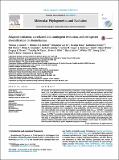Por favor, use este identificador para citar o enlazar a este item:
http://hdl.handle.net/10261/169149COMPARTIR / EXPORTAR:
 SHARE SHARE
 CORE
BASE CORE
BASE
|
|
| Visualizar otros formatos: MARC | Dublin Core | RDF | ORE | MODS | METS | DIDL | DATACITE | |

| Título: | Adaptive radiation, correlated and contingent evolution, and net species diversification in Bromeliaceae |
Autor: | Givnish, T.J.; Riina, Ricarda CSIC ORCID; Sytsma, K.J. | Palabras clave: | Evolutionary predictions Species richness Pollination syndromes Key innovations Biogeography Epiphytes |
Fecha de publicación: | 2014 | Editor: | Academic Press | Citación: | Molecular Phylogenetics and Evolution 71 : p. 55- 78 (2014) | Resumen: | We present an integrative model predicting associations among epiphytism, the tank habit, entangling seeds, C3 vs. CAM photosynthesis, avian pollinators, life in fertile, moist montane habitats, and net rates of species diversification in the monocot family Bromeliaceae. We test these predictions by relating evolutionary shifts in form, physiology, and ecology to time and ancestral distributions, quantifying patterns of correlated and contingent evolution among pairs of traits and analyzing the apparent impact of individual traits on rates of net species diversification and geographic expansion beyond the ancestral Guayana Shield. All predicted patterns of correlated evolution were significant, and the temporal and spatial associations of phenotypic shifts with orogenies generally accorded with predictions. Net rates of species diversification were most closely coupled to life in fertile, moist, geographically extensive cordilleras, with additional significant ties to epiphytism, avian pollination, and the tank habit. The highest rates of net diversification were seen in the bromelioid tank-epiphytic clade (Dcrown=1.05My-1), associated primarily with the Serra do Mar and nearby ranges of coastal Brazil, and in the core tillandsioids (Dcrown=0.67My-1), associated primarily with the Andes and Central America. Six large-scale adaptive radiations and accompanying pulses of speciation account for 86% of total species richness in the family. This study is among the first to test a priori hypotheses about the relationships among phylogeny, phenotypic evolution, geographic spread, and net species diversification, and to argue for causality to flow from functional diversity to spatial expansion to species diversity. © 2013 Elsevier Inc. | URI: | http://hdl.handle.net/10261/169149 | DOI: | 10.1016/j.ympev.2013.10.010 | Identificadores: | doi: 10.1016/j.ympev.2013.10.010 issn: 1055-7903 |
| Aparece en las colecciones: | (RJB) Artículos |
Ficheros en este ítem:
| Fichero | Descripción | Tamaño | Formato | |
|---|---|---|---|---|
| Adaptive radiation correlated and contingent evolution.pdf | 1,69 MB | Adobe PDF |  Visualizar/Abrir |
CORE Recommender
SCOPUSTM
Citations
291
checked on 13-abr-2024
WEB OF SCIENCETM
Citations
284
checked on 22-feb-2024
Page view(s)
303
checked on 18-abr-2024
Download(s)
759
checked on 18-abr-2024
Google ScholarTM
Check
Altmetric
Altmetric
NOTA: Los ítems de Digital.CSIC están protegidos por copyright, con todos los derechos reservados, a menos que se indique lo contrario.
